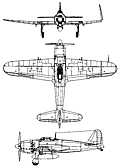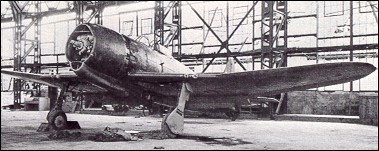|
| The design by Mitsubishi of a carrier-based fighter to supersede the A6M Zero-Sen had been planned by the Japanese navy as early as 1940, but was frustrated, by the company's involvement in urgent development and- production programmes. It was not until 1942 that design of the M-50 Reppu (hurricane) began, but the continuing pressure on Mitsubishi for developments of the ABM meant that it was not until 6 May 1944 that the first prototype, which by then had the company designation Mitsubishi A7M1, was flown for the first time. A cantilever low-wing monoplane with retractable tailwheel landing gear, the A7M1 soon revealed excellent flight characteristics, but as predicted by Mitsubishi the type's maximum speed on the power of the installed Nakajima NK9K Homare 22 engine was below specification. Further testing was abandoned until availability of the 1641kW Mitsubishi MK9A radial engine made it possible to build seven A7M2 prototype and service trials aircraft, the first prototype being flown on 13 October 1944. Clearly a potent fighter that could meet Allied opposition on equal terms, the Reppu had a maximum speed of 630km/h at optimum altitude and was ordered into production as the Navy Carrier Fighter Reppu Model 22.
Unfortunately, by then it was too late for the Japanese navy, Allied air attacks and an earthquake limiting production to only one aircraft. Development of similar land-based fighters was planned under the designations A7M3 and A7M3-J, but neither was built before the war ended.

| MODEL | A7M2 |
| CREW | 1 |
| ENGINE | 1 x Mitsubishi MK9A, 1650kW |
| WEIGHTS |
| Take-off weight | 4720 kg | 10406 lb |
| DIMENSIONS |
| Wingspan | 14 m | 46 ft 11 in |
| Length | 11 m | 36 ft 1 in |
| Height | 4.28 m | 14 ft 1 in |
| Wing area | 30.86 m2 | 332.17 sq ft |
| PERFORMANCE |
| Max. speed | 620 km/h | 385 mph |
| Cruise speed | 410 km/h | 255 mph |
| Ceiling | 10900 m | 35750 ft |
| ARMAMENT | 4 x 20mm cannons, 2 x 250-kg bombs |
 | A three-view drawing (752 x 1049) |
| Dominic, 04.10.2010 05:44 Guys, remember that the Ki-84 "Hayate" was equal to the Hellcat and Corsair in all respects, they just never got to fight at full potential due to a lack of skilled pilots and horrible fuel. Same with the Kawanishi N1K-J Shiden.
The A7M, if piloted by pilots with skill equal to their American counterparts, would've laid waste to anything the Allies could've put in the air in 1945. Period. reply | | MAXWELL POKU, e-mail, 30.06.2010 10:19 THIS IS AN INTERNET FLAUD. THESE PEOPLE ARE HERE JUST TO TAKE YOUR MONEY AND RUN. PLEASE DON'T FALL FOR THESE STUPID STORIES. THEY ARE NOT TRUE. reply |
| alb, e-mail, 15.05.2010 03:22 I think that Jiro Horikoshi scaled the A6M up to adapt the 18 cylinder engine to good effect. reply | | Steve, e-mail, 04.08.2009 22:55 In their successors to the Zero and the Wildcat, it is remarkable how Mitsubishi and Grumman produced very similar aircraft in the Reppu and Hellcat. reply | |
| | sanjeet, e-mail, 25.06.2009 09:22 hellcat has its own night vision than a6m3 zero which is blind at night but if that era american got bearcat this planes would not survive and destroy reply | | Leo Rudnicki, e-mail, 20.06.2009 16:56 There were 8 prototype aircraft built. First flight October 1944. Earthquake in December 1944, followed by B-29's dropping bombs all over. Had US submarines not sunk all the tankers supplying oil to Japan, had they used convoy protection, had they enough tankers in the first place, had they planned to fight a longer war, Had they trained vastly greater numbers of good pilots (good teachers had all burned to death on 4 carriers off Midway), had Adm's Nagumo and Kurita not dithered, at Pearl and Leyte, they would have still lost. There was no myth of P-51 invincibility. Pilots died. There was an historical fact of P-51 superiority, not just plane but pilots as well. Actually, they lost the war at the 'canal, bushido versus semper fi. The planes were just machines that they used. reply | | sanjeet singh gill, e-mail, 20.06.2009 15:05 how to know that it is high in manuering?, and is there any video about this kind of aircraft?, and what is its maneuring angle? .Can it fight the p 51 d mustang this is wierd aircraft right.D anyone can answer ma please reply | | Darryl, e-mail, 31.05.2009 05:45 I read that book "Samurai" by Saburo Sakai. Great book, He does mention the Reppu also the Shinden and Raiden (pg. 242). Participants on all sides had great skill and courage. reply | | Hiroyuki Takeuchi, e-mail, 30.01.2009 02:55 I had a chance to personally interview the late Lt.Cdr.(Ret) Yoshio Shiga who test flew the A6M1 prototype. He said the plane was very docile to fly. "A well mannered lady, compared to the N1K2-J Shiden-kai which was more of a tom-boy. " reply | | mac_bolan00, e-mail, 08.12.2008 02:08 i would think the nakajima shiden would have out-flown the p-51D at medium altitude and the mitsubishi zero could out-dogfight any plane at low altitude until the war's end. reply |
| Mick Dunn, e-mail, 23.11.2008 07:31 At the end of the dear readers, it all came down to NUMBERS! Pilots and Planes!
If there were equal numbers (to USA) of even the good old Zero left in 1944 and with pilots of equal training to fly them...America would have had a helluva fight on her hands! reply | | Sam Turner, e-mail, 17.09.2008 05:38 Did this airplane have combat flaps? and was the a7m3 planned to have 6 20mm cannons and 4 30mm cannons and 2 rear fusaloge [sry if i spelled that wrong] 30mm cannons? [thanks for the answers, and nice website] reply | | Andrew, e-mail, 13.09.2008 07:55 If you want to know how the Reppu handled, read the book "Samurai" by Saburo Sakai, Japan's greatest surviving WWII ace. He mentions it near the end of his book. reply |
| Sam Turner, e-mail, 22.04.2008 04:59 do you know how the reppu handled? (in general)
like was it more manuverable than the Zero or KI 84?
more armor? etc. reply | |
| | Gautier, e-mail, 10.03.2008 23:06 of course, even if this plane had entered service in 1944, this wouldn't have change history.but if japanese had an engine development program as Pratt & Witney did, such a plane could had reach production as early as '42.japanese would'nt had lost so much experienced pilots and US air forces would had been in big trouble.the A7M2 was climbing fast, was as big but far more manoeuvrable than a P-47, and had enought armament punch.not to mention the diving speed, armor and range.by the way, construction seemed more sturdy and ceiling superior to the KI-84.this plane was a very serious threat for allies. reply | | bill, e-mail, 03.03.2008 01:24 With the event of the P47N and the P51D with the experienced pilots the US had t is hard to believe this fighter would have had any more impact than the Nakajina Ki84 Frank did. reply | | saiful bahktiar, e-mail, 28.02.2008 05:45 banzaiiiiii reply | | Andrew, e-mail, 24.01.2007 01:41 It looks like a great plane and from the sound of prototype testing it could have helped the Japanese a lot! Once again the myth of the P-51 being this invincible aircraft is broken. I am sure SAM with a good pilot could go toe to toe with any American plane of the era..Nice website reply |
|
Do you have any comments?
|
| 
COMPANY
PROFILE
All the World's Rotorcraft
|








 mac_bolan00
mac_bolan00
20
reply